CROWNS & BRIDGES are fixed teeth replacements that are bonded or cemented on to the existing teeth or implant and function exactly like your natural teeth.
- Crowns fix and protect teeth that are so damaged or diseased that they need more support than a simple filling.
- Bridges replace missing teeth and offer support for the surrounding teeth to help retain the integrity of the jaw and face structure.
Also called as “caps” they are used to restore and strengthen broken down damaged teeth. They mimic the colour shape and size of the neighbouring natural teeth .It covers and protects the entire tooth.
Dr Turner and his team of Prosthodontists and Restorative dentists recommend a crown in the following situations:
- A large and heavily filled tooth with very little natural tooth structure remaining.
- A fractured , broken down tooth thereby protecting the remaining underlying tooth.
- Root canal treated teeth : After root canal therapy is performed, a tooth becomes extremely brittle and is significantly weaker.
- To cover discoloured , malformed or poorly shaped teeth.
Case : Crown fabricated at Dr. Turners’
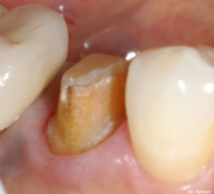 Before
BeforeTooth prepared to receive a crown
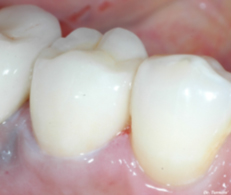 After
AfterAn ALL-CERAMIC Zirconia (Procera) crown.
The missing teeth are replaced with an artificial tooth connected between 2 crowns (caps) that are permanently connected on the adjacent teeth. They are permanent, fixed alternatives to tedious removable partial dentures.
If you have missing teeth, a bridge prevents the remaining natural teeth from shifting, so that dental arch integrity and esthetics are not compromised.
Case : Crown fabricated at Dr. Turners’
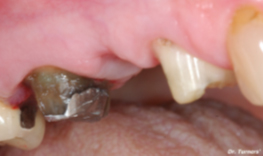 Before
Before2 teeth prepared to receive a 3-unit bridge
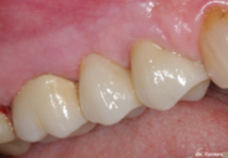 After
AfterA 3-unit fixed bridge permanently cemented
Before either a crown or a bridge can be made, the tooth (or teeth) must be reduced in size so that the crown or bridge will fit over it properly. After reducing the tooth/teeth, we will take an impression of the prepared teeth to provide an exact mold for the crown or bridge.
We then send these impressions to our very own State of the Art Dental technological laboratory center which under the watchful eye of our superbly skilled Master technologist Mr.Danesh fabricates the crowns and bridges. This we believe gives us the synergistic advantage in getting the best fit , shape, size and colour of your final crowns and bridges.
This in turn reflects on the longevity (over 12-15 years)and the final aesthetics and beauty of your new smile!!
Very few or maybe not, dental practices have a full fledged laboratory support which we believe gives us the edge over the others.
A temporary crown or bridge will always be put in place to cover the prepared tooth while the permanent crown or bridge is being made. When the permanent crown or bridge is ready, the temporary crown or bridge is removed, and the new crown or bridge is cemented over your prepared tooth or teeth.


While crowns and bridges can last a lifetime,(over 12-15 years) they do sometimes come loose or fall out. The most important step you can take to ensure the longevity of your crown or bridge is to practice good oral hygiene.
A bridge can lose its support if the teeth or bone holding it in place are damaged by dental disease.
Keep your gums and teeth healthy by brushing with fluoride toothpaste twice a day and flossing daily. Also see your dentist and hygienist regularly for checkups and professional cleanings.
To prevent damage to your new crown or bridge, avoid chewing hard foods, ice or other very hard objects.
Porcelain fused to Metal (Ceramo metal restorations):
They have been used for over 20 years now They have a nearly natural appearance, subject to two limitations: Because they have a metal framework underneath, they do not allow light to pass through them giving them an opaque look. Our natural teeth on the other hand are translucent and they allow the transmission of light unlike the porcelain fused to metal which makes it impossible to fully re-create the translucency of natural teeth.
They also eventually will show a dark line at the edge, next to the gum. Dentists try to hide this line under the gum, but sometimes they are unable to do this; and sometimes the line doesn’t show when the crown is first placed but shows later, as the gum recedes.
All Ceramic (Zirconia & Alumina) Crowns & Bridges (PROCERA) : (CAD CAM technology)
Crowns that not only are more esthetic and gum friendly but also as strong as porcelain fused to metal crowns. The core of these crowns (alumina or zirconia)are fabricated in Sweden and arrive at our dental laboratory in 7 days after your appointment and can be fit in your mouth 3 days later, giving you an enhanced more life like result and impeccable beauty and esthetics mimicking that of natural teeth.
There in no black metal line seen ever since they are All ceramic and at the same time allow the transmission of light similar to your natural teeth giving lifelike aesthetics.
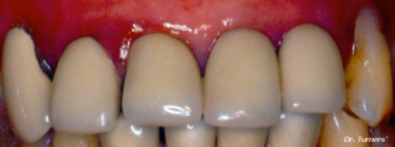 Before
Before5 Opaque looking dull porcelain fused to metal crowns displaying black lines at the gum level and unhealthy gingiva (gums)
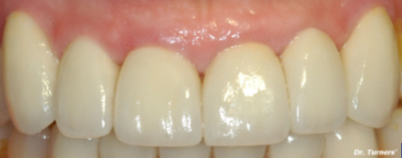 After
After6 All ceramic Procera (Nobel Biocare, Sweden) crowns displaying lifelike vitality and healthy gingiva
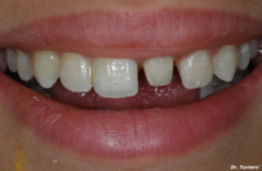
Before
Root canal treated tooth prepared to receive a crown.
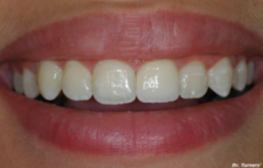
After
Excellent color match and perfect fit completes her smile.
 Before
BeforeA combination of crowns and bridges in the upper 10 teeth. Note the black lines visible at the gum margin and the overall dull appearance.
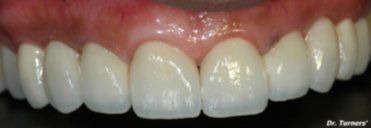 After
AfterAll ceramic Procera (Nobel Biocare, Sweden) crowns and bridges give him an even row of natural looking gleaming white teeth.
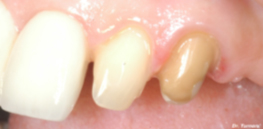 Before
BeforeTeeth prepared to receive a bridge.
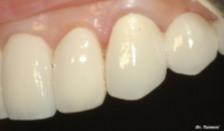 After
AfterBridge in place.
